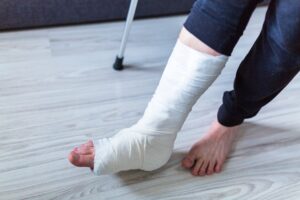By Stephen Bishop. Last Updated 9th May 2024. If you’ve suffered a broken ankle at work due to your employer being negligent, then you could be owed compensation. This article focuses on making a personal injury claim for an accident at work, the compensation you could be owed, and how you can support a claim with evidence.
You can get in touch with our advisors at any time of the day or night if you have any questions regarding a potential claim for a broken ankle at work. They can provide you with free advice and could even connect you with one of the No Win No Fee solicitors from our panel to help you with your claim.
Read on for more information, and reach out using any of the following methods:
- Call us on 0161 696 9685
- Contact us via our website
- Use the pop-up chat window in the corner
Select A Section
- Can I Make A Broken Ankle At Work Claim?
- How Long Do You Have To Claim For A Fractured Or Broken Ankle?
- What Documentation And Evidence Supports Accident At Work Claims
- Broken Ankle At Work Compensation Examples
- Could I Make A Broken Ankle At Work Claim With A No Win No Fee Solicitor?
- Further Guidance On Accident At Work Claims
Can I Make A Broken Ankle At Work Claim?
Certain criteria must be met in order for you to make a valid personal injury claim for a broken ankle at work. The duty that your employer owes to you, as stated in the Health and Safety at Work etc. Act 1974, requires your employer to take all reasonable steps that prevent their employees from being injured in the workplace.
The duty of care relates heavily to the criteria your claim needs to meet. Here they are:
- Duty of care – You’re required to prove that, at the time of your injury, you were owed a duty of care.
- Breach of duty – When your employer doesn’t uphold their duty of care, it’s said that they have breached it. For example, your employer may not have provided you with necessary Personal Protective Equipment (PPE), such as safety boots.
- Harm caused – A breach of an employer’s duty of care needs to have caused your injury. If you are not injured, you cannot make a workplace injury claim.
If you have any questions about filing a claim for a broken ankle at work, please do not hesitate to contact us.
How Long Do You Have To Claim For A Fractured Or Broken Ankle?
There is a limitation period to consider when you’re making a claim. Found in the Limitation Act 1980, the legal time limit in which you must begin legal proceedings is generally 3 years. This time limit begins from the date you were injured.
The same Act that states this limitation period also contains scenarios where exceptions can be made. In other words, it can sometimes still be possible to begin a claim after the 3-year window has expired.
We’ve included the exceptions below:
- Child injury claims – Anyone under 18 is not permitted to make their own claim until they reach adulthood. Therefore, their 3-year time limit only begins from their 18th birthday.
- Those who do not possess the mental capacity to claim – If this is the case, their time limit is indefinitely suspended. However, it would begin if they were ever to become capable of making their own claim.
In both instances above, a litigation friend can be appointed to claim on behalf of someone incapable or a minor. A litigation friend is an adult who has the injured person’s best interests in mind. It could be a parent, relative, family friend, or a legal professional such as a solicitor.
For more information, get in touch with our advisors today to see if you could make an accident at work claim.
What Documentation And Evidence Supports Accident At Work Claims
When making an accident at work claim, supporting it with evidence is very important. In this section, we’ve compiled a short list containing some examples of evidence you could acquire.
- Workplace accident book – Someone in a position of authority in your workplace will need to fill this out following an injury. There will be details such as dates, times, and how the accident that caused the injury occurred.
- Video evidence – If your workplace has CCTV cameras, the accident may have been captured. You have the legal right to request the footage if you appear in it.
- Photographs – Document your physical injuries by taking pictures of them. You can also take photos of the hazards that caused the accident in which you were injured.
- Medical evidence – As well as accessing your medical records, you should also be given a hospital discharge letter when you’re released from their care.
- Witness contact details – Make sure you have a way of getting in touch with anyone who saw how you were injured. Colleagues are a good example of this. If you have a solicitor assisting you with your case, they can then reach out to these witnesses and ask them to submit a statement.
If you’d like more information regarding how you can support a workplace accident claim with evidence, get in touch with our advisors today.
Broken Ankle At Work Compensation Examples
Compensation for a broken ankle at work claim will include general damages. This head of loss compensates you for the pain and suffering your injury at work has caused you to experience.
The table below includes some of the compensation guidelines listed within the Judicial College Guidelines (JCG) that relate to ankle injuries. This is a document that may be used by those valuing your work accident claim for general damages, since it lists various types of physical and psychological injuries alongside guideline compensation brackets.
Please note that the table below should be viewed as a guide only. The first entry in the table is not based on the JCG.
| Injury | Severity | Notes | Amount |
|---|---|---|---|
| Multiple Serious Injuries Plus Special Damages | Serious | If you are eligible to claim for multiple serious injuries, including one to the ankle, then you could receive a payout covering all of these plus any related special damages, such as the cost of home care provisions. | Up to £200,000+ |
| Ankle | Very severe | (a) As well as a transmalleolar ankle fracture, there will also be other extensive damaged. Furthermore, there may be a future need to amputate the leg below the knee if another injury occurs. | £61,090 to £85,070 |
| Ankle | Severe | (b) Pins and plates will have been inserted. There may have been the requirement for a long period in plaster or a long period of other forms of treatment. Employment may be impacted, as well as sleep. | £38,210 to £61,090 |
| Ankle | Moderate | (c) Ligament tears and fractures making walking or standing for long periods difficult. | £16,770 to £32,450 |
| Ankle | Modest | (d) Injuries that are less serious in nature, such as sprains and undisplaced fractures. | Up to £16,770 |
| Achilles Tendon | Most serious | (a) When the peroneus longus muscle and the Achilles tendon are severed. There will be swelling, cramp and the restriction of ankle movement. | In the region of £46,900 |
| Achilles Tendon | Serious | (b) Although the tendon will have be completely divided, it has since been repaired. The sufferer will have gained a limp and had their ankle movements restricted. | £30,500 to £36,720 |
| Achilles Tendon | Moderate | (c) A partial rupture or an injury to the tendon of a significant nature. | £15,370 to £25,710 |
| Achilles Tendon | Minor | (d) Some damage to the tendon will be caused due to a turning of the ankle. | £8,870 to £15,370 |
If you can claim for general damages, then special damages could also be awarded as part of your broken ankle at work compensation. This compensates for any financial expenses or losses you’ve experienced due to your injury. Examples of losses that may be covered by your claim include:
- The cost of certain treatments, including medicines or physiotherapy.
- Loss of earnings if your injury has led you to take unpaid time off work.
- Travel expenses to crucial appointments.
Certain evidence can be provided to help you claim special damages, such as bank statements and wage slips.
For more advice on potential payouts for a broken ankle at work, please contact our advisors for free today.
Could I Make A Broken Ankle At Work Claim With A No Win No Fee Solicitor?
When making a claim following a broken ankle at work, you may consider doing so with the help of one of the solicitors from our panel. If so, they can work with you under a form of No Win No Fee arrangement called a Conditional Free Agreement (CFA).
A CFA allows you full access to your solicitor’s legal services without the requirement of paying them anything upfront. They do, however, take a fee from your compensation if your claim is successful. This fee is a legally capped percentage of your compensation. It’s called a success fee, and it is not taken from you if your claim fails.
Speak To Us About Your Claim
Speak with our advisors today for free. We don’t charge for the guidance provided, and it won’t cost you anything to get in touch. If your claim is valid and you wish for us to connect you with a No Win No Fee solicitor from our panel, then we can do so. However, there is no obligation to claim once you have spoken with us.
Get in touch:
- Call us on 0161 696 9685
- Contact us via our website
- Use the pop-up chat window in the corner
Further Guidance On Accident At Work Claims
The links below will take you to extra reading material that you could find helpful.
More from us:
- You could be owed compensation for a broken foot after an accident at work.
- A broken rib/crush injury could have occurred due to negligence in the workplace.
- Broken ankles could also be relevant in manual handling claims. Get in touch to find out more.
Information from other sources:
- Specified injuries to workers need to be reported to the Health and Safety Executive (HSE) under the Reporting of Injuries, Diseases and Dangerous Occurrences Regulations 2013 (RIDDOR).
- As some legal jargon can be difficult to understand, the Solicitors Regulation Authority (SRA) has simplified some commonly used terminology.
- As a broken ankle could occur to you in various settings, the NHS has written a helpful guide on the injury.
Thank you for reading our guide on the process of claiming compensation in the wake of a broken ankle at work.




